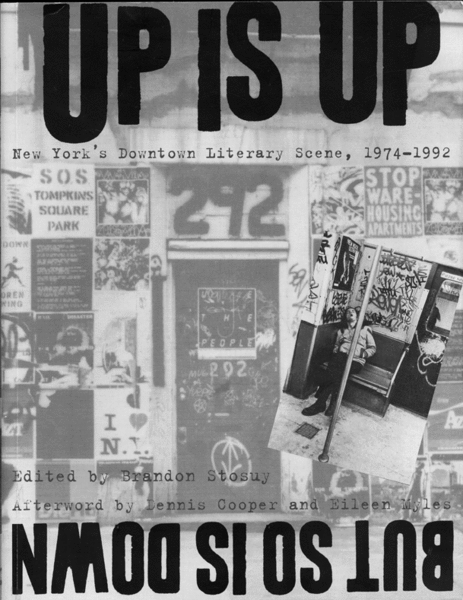Anyone who spent time in lower Manhattan during the years covered in editor Brandon Stosuy’s rich and riveting anthology, Up Is Up But So Is Down, will tell you the same thing: Their city is gone, its gritty, exciting, and dangerously vibrant bones since plowed up and paved over with a staid world of lattes, limos, and velvet ropes. It all feels like punk never happened, like that Starbucks on St. Marks Place has been squatting there forever.
But, of course, punk did happen. And it deeply and indelibly impacted popular culture, and continues to do so more than 30 years since the days when pioneering musicians like Richard Hell and Patti Smith began performing. Yet while it’s mainly seen as a musical phenomenon, punk was by no means limited to the noisy notes on records and bills at CBGB and Max’s Kansas City. It was a philosophical and aesthetic revolution that shook all disciplines—the visual arts, film, graphic design, theater, and, yes, even literature. In recent years, there’s been a wave of interest in this vital period: CD reissues flood the music stores; movies depict Jean-Michel Basquiat and Andy Warhol; the prize-winning musical “Rent” romanticizes the lives of struggling East Villagers; scene fixtures like Jim Jarmusch and Steve Buscemi translate their Downtown experiences to the big screen; and even the output of Madison Avenue references punk’s torn-and-scrawled graphic style.
Until this compendium, there has been no significant effort to encapsulate New York’s ’70s-’90s Downtown writing. Up Is Up But So Is Down is a fascinating and long-needed overview of a hugely creative and overlooked literary period. Most of these writers may not have been punks in the card-carrying, leather jacket-wearing sense, but their craft embodies the movement’s M.O. The work here—not only that of writer-musicians like Hell, Smith, Thurston Moore, Laurie Anderson, and Lydia Lunch, but also of firebrands like Kathy Acker, David Wojnarowicz, Gary Indiana, Spalding Gray, Karen Finley, and Patrick McGrath—comprises some of the rawest and most provocative gut-level street prose to hit the page. Pieces like Eric Bogosian’s claustrophobic confessional “In the Dark” and Bob Witz’s bleak, headline-plundering “Newspaper Poem” could only have come from Downtown New York in its years of golden grime.
That’s not to say that it’s all sobering urban gloom. There’s some really funny stuff here, though naturally it edges toward the black side. Take “Modern Saint #271,” Tama Janowitz’s narrative about a prostitute and her lover’s shared addiction to heroin: “Neither of us was a very good housekeeper.” Or Hal Sirowitz’s poem, “Lunch Break,” about a father who regularly takes his repast in a porno theater: “He would rather go to the cowboy movies, / But the gunfire hurts his ears.”
Readers of this magazine will no doubt be struck by the volume’s abundance of writers with Hudson Valley ties, once and future upstate personalities like Gray, Finley, Ed Sanders, Penny Arcade, Mary Gaitskill, Thaddeus Ruttkowski, and Barbara Ess—not to mention Chronogram contributors Sparrow and Roberta Allen (but why is Mikhail Horowitz pictured on the spine and not a featured contributor?).
Up Is Up But So Is Down’s colorfully tinted pages are packed with eye-boggling ephemera: Robert Mapplethorpe’s 1984 shots of an attitude-oozing Acker; Dada-esque mail art like Dennis Cooper’s collage portraying teen idol Leif Garret with a gun in his mouth; and covers from zines like Between C and D, which was pumped out on a dot-matrix printer and marketed in Ziploc bags like those used by Losaida drug dealers. Also here are wads of flyers for gigs and readings, like a 1978 handbill for a show by Hell’s band, the Voidoids, which quotes the Comte de Lautremont, and poet Eileen Myles’s pre-Pagemaker announcements, scribbled across sheets of grade-school ruled paper.
But it’s the text that’s the true meat of this hefty slab, which weighs in at more than 500 pages. And the collective power of these hard-hitting, back-alley words will knock you flat on your ass. In this case, a good place to be.
—Peter Aaron
- Home
- Arts
- Food & Drink
- Towns
- Home & Design
-
Towns
- Accord
- Amenia
- Beacon
- The Berkshires
- Catskill
- Chatham
- Cold Spring
- Cornwall
- Ellenville
- Gardiner
- Garrison
- Germantown
- Goshen
- Great Barrington
- Hunter
- High Falls
- Highland
- Hillsdale
- Hopewell Junction
- Hudson
- Hyde Park
- Kerhonkson
- Kinderhook
- Kingston
- Marlboro
- Middletown
- Millbrook
- Millerton
- Montgomery
- Mount Tremper
- New Paltz
- New Windsor
- Newburgh
- Orange County
- Pawling
- Peekskill
- Phoenicia
- Poughkeepsie
- Putnam County
- Red Hook
- Rhinebeck
- Rosendale
- Saugerties
- Stone Ridge
- Sugar Loaf
- Tivoli
- Wappingers Falls
- Warwick
- Woodstock
- Westchester
- Lifestyle
- Horoscopes
- Cannabis
- Wellness
- The River
- Events
- Chronogrammies
- Newsletters
- Add Your Event
- Support Us
- Login
- sign in
- Username
[]
About The Author
Support Chronogram
Related Content
Website
Chronogram


















